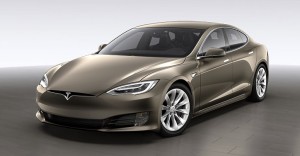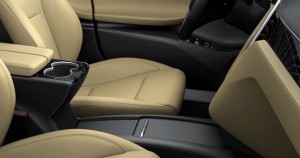News
Exploring Details Behind the Tesla Model S Update

After four years on the market, Tesla has quietly released a new styling update for the Model S aligning it with the design found on the Model X and Model 3 prototype.
Tesla CEO Elon Musk has once said that Tesla continues to improve on their vehicles making sometimes twenty engineering design changes per week, with many of them being released via over-the-air software updates, but major redesigns are few and far between.
Let’s take a closer look at what the new Model S “refresh” introduced.
Exterior Design Updates
The most noticeable exterior update is the new front-end of the Model S which looks most like the front-end of the Model X.
- 2016 Tesla Model S revised front end
- Red Tesla Model X with Silver 20″ Wheels
Though they look very similar in design, the Model S looks even sleeker due to the lower profile over the Model X. The revised look keeps the Model S modern in appearance, but subtle enough that it still remains true to its original contour and body lines.
One update that easily goes unnoticed is the relocation of the front facing radar. Because of the new grill-less design of the Model S, the Tesla design team had to move the radar up from the bottom grill to the open space behind the Tesla emblem. This not only helps with functionality because of a higher mounting position with potentially less obstruction, but the new hidden location makes the car look a heck of a lot better.
Also improved on the exterior are the headlights which are now adaptive LED headlamps that adjust according to the curvature of the road. This is standard equipment found on the Model X but also seen on the Model 3 prototypes.
Interior Design Updates
The interior treatment of the Model S received a few new updates as well. Tesla has included a standard center console that looks to be the same one from the Model X.
- Revised Tesla Model S center console
- Tesla Model X Front Interior
Tesla Model S (left) vs Model X (right) interior
Tesla has also added a Figured Ash as an available interior trim. This trim has been very popular among Model X buyers, but it also happens to be a personal favorite of mine.
Additional Features
 The Model S onboard charger has been upgraded from a 40A standard charger to a 48A standard charger, with an option to further increase charging rate by opting for a 72A “high amperage” charger. The older Model S configurations offered a 40A charger standard with an option to upgrade to 80A (‘dual chargers‘).
The Model S onboard charger has been upgraded from a 40A standard charger to a 48A standard charger, with an option to further increase charging rate by opting for a 72A “high amperage” charger. The older Model S configurations offered a 40A charger standard with an option to upgrade to 80A (‘dual chargers‘).
Tesla also made the automatic lift gate now a standard option which makes sense for a premium vehicle in this price range.
Included in the premium upgrade package is the BioWeapon defense mode air filtration system, as well as ambient interior lighting (previously an optional upgrade).
Pricing
While there were many rumors of a Model S price increase leading up to this design refresh, the new updates do not seem to be reflected in the price.
“The new Model S may actually be less expensive than before”
I priced out the latest Model S with options that I chose from before, and compared the new price side by side with one I previously saved.
The price from before was $98,450 and the new price is $104,450, but despite the price difference there are a couple of key differences which makes for the price disparity. Let me explain.
The last time I configured a Model S I couldn’t locate a high amperage/dual charger option so my $98,450 does not include that option. On the other hand, the updated Model S comes with a 48A charger as a standard feature. This is included in the base price of the vehicle.
Tesla also no longer offers the S85D which I priced-out back then, so this new price is for the 90D. In the past the extra 5 kWh was a $3,000 option.
If you back both of those out to the new price you get to a price difference of $99,950 or a price increase of $500. Keep in mind that the updated Model S also comes with a center console (previously a $650 extra charge) and the new air filtration system. Depending on how you look at it, the new Model S may actually be less expensive than before.
One could easily make the case that the new offering is an improvement over what Tesla offered before and is actually less expensive.
Summary
It’s great to see Tesla keeping the Model S design fresh and current despite all of the activity going on within the company, let alone conquering challenges with launching the Model X and preparing for the Model 3. Being able to pull off this current update – factoring in changes to production, logistics, service, etc – Tesla continues to defy naysayers and show the world what ingenuity and perseverance can accomplish in such a short amount of time.

Elon Musk
SpaceX issues statement on Starship V3 Booster 18 anomaly
The incident unfolded during gas-system pressure testing at the company’s Massey facility in Starbase, Texas.

SpaceX has issued an initial statement about Starship Booster 18’s anomaly early Friday. The incident unfolded during gas-system pressure testing at the company’s Massey facility in Starbase, Texas.
SpaceX’s initial comment
As per SpaceX in a post on its official account on social media platform X, Booster 18 was undergoing gas system pressure tests when the anomaly happened. Despite the nature of the incident, the company emphasized that no propellant was loaded, no engines were installed, and personnel were kept at a safe distance from the booster, resulting in zero injuries.
“Booster 18 suffered an anomaly during gas system pressure testing that we were conducting in advance of structural proof testing. No propellant was on the vehicle, and engines were not yet installed. The teams need time to investigate before we are confident of the cause. No one was injured as we maintain a safe distance for personnel during this type of testing. The site remains clear and we are working plans to safely reenter the site,” SpaceX wrote in its post on X.
Incident and aftermath
Livestream footage from LabPadre showed Booster 18’s lower half crumpling around the liquid oxygen tank area at approximately 4:04 a.m. CT. Subsequent images posted by on-site observers revealed extensive deformation across the booster’s lower structure. Needless to say, spaceflight observers have noted that Booster 18 would likely be a complete loss due to its anomaly.
Booster 18 had rolled out only a day earlier and was one of the first vehicles in the Starship V3 program. The V3 series incorporates structural reinforcements and reliability upgrades intended to prepare Starship for rapid-reuse testing and eventual tower-catch operations. Elon Musk has been optimistic about Starship V3, previously noting on X that the spacecraft might be able to complete initial missions to Mars.
Investor's Corner
Tesla analyst maintains $500 PT, says FSD drives better than humans now
The team also met with Tesla leaders for more than an hour to discuss autonomy, chip development, and upcoming deployment plans.

Tesla (NASDAQ:TSLA) received fresh support from Piper Sandler this week after analysts toured the Fremont Factory and tested the company’s latest Full Self-Driving software. The firm reaffirmed its $500 price target, stating that FSD V14 delivered a notably smooth robotaxi demonstration and may already perform at levels comparable to, if not better than, average human drivers.
The team also met with Tesla leaders for more than an hour to discuss autonomy, chip development, and upcoming deployment plans.
Analysts highlight autonomy progress
During more than 75 minutes of focused discussions, analysts reportedly focused on FSD v14’s updates. Piper Sandler’s team pointed to meaningful strides in perception, object handling, and overall ride smoothness during the robotaxi demo.
The visit also included discussions on updates to Tesla’s in-house chip initiatives, its Optimus program, and the growth of the company’s battery storage business. Analysts noted that Tesla continues refining cost structures and capital expenditure expectations, which are key elements in future margin recovery, as noted in a Yahoo Finance report.
Analyst Alexander Potter noted that “we think FSD is a truly impressive product that is (probably) already better at driving than the average American.” This conclusion was strengthened by what he described as a “flawless robotaxi ride to the hotel.”
Street targets diverge on TSLA
While Piper Sandler stands by its $500 target, it is not the highest estimate on the Street. Wedbush, for one, has a $600 per share price target for TSLA stock.
Other institutions have also weighed in on TSLA stock as of late. HSBC reiterated a Reduce rating with a $131 target, citing a gap between earnings fundamentals and the company’s market value. By contrast, TD Cowen maintained a Buy rating and a $509 target, pointing to strong autonomous driving demonstrations in Austin and the pace of software-driven improvements.
Stifel analysts also lifted their price target for Tesla to $508 per share over the company’s ongoing robotaxi and FSD programs.
Elon Musk
SpaceX Starship Version 3 booster crumples in early testing
Photos of the incident’s aftermath suggest that Booster 18 will likely be retired.

SpaceX’s new Starship first-stage booster, Booster 18, suffered major damage early Friday during its first round of testing in Starbase, Texas, just one day after rolling out of the factory.
Based on videos of the incident, the lower section of the rocket booster appeared to crumple during a pressurization test. Photos of the incident’s aftermath suggest that Booster 18 will likely be retired.
Booster test failure
SpaceX began structural and propellant-system verification tests on Booster 18 Thursday night at the Massey’s Test Site, only a few miles from Starbase’s production facilities, as noted in an Ars Technica report. At 4:04 a.m. CT on Friday, a livestream from LabPadre Space captured the booster’s lower half experiencing a sudden destructive event around its liquid oxygen tank section. Post-incident images, shared on X by @StarshipGazer, showed notable deformation in the booster’s lower structure.
Neither SpaceX nor Elon Musk had commented as of Friday morning, but the vehicle’s condition suggests it is likely a complete loss. This is quite unfortunate, as Booster 18 is already part of the Starship V3 program, which includes design fixes and upgrades intended to improve reliability. While SpaceX maintains a rather rapid Starship production line in Starbase, Booster 18 was generally expected to validate the improvements implemented in the V3 program.
Tight deadlines
SpaceX needs Starship boosters and upper stages to begin demonstrating rapid reuse, tower catches, and early operational Starlink missions over the next two years. More critically, NASA’s Artemis program depends on an on-orbit refueling test in the second half of 2026, a requirement for the vehicle’s expected crewed lunar landing around 2028.
While SpaceX is known for diagnosing failures quickly and returning to testing at unmatched speed, losing the newest-generation booster at the very start of its campaign highlights the immense challenge involved in scaling Starship into a reliable, high-cadence launch system. SpaceX, however, is known for getting things done quickly, so it would not be a surprise if the company manages to figure out what happened to Booster 18 in the near future.













